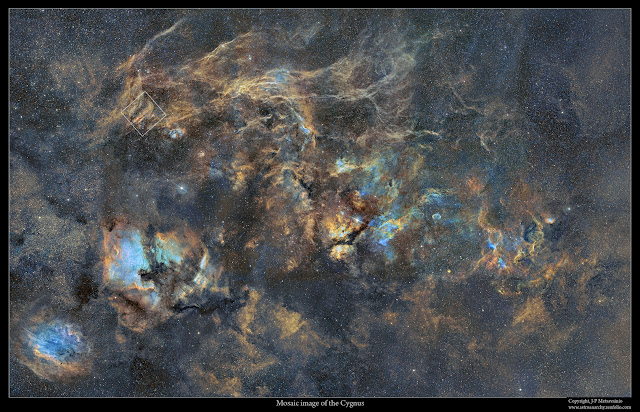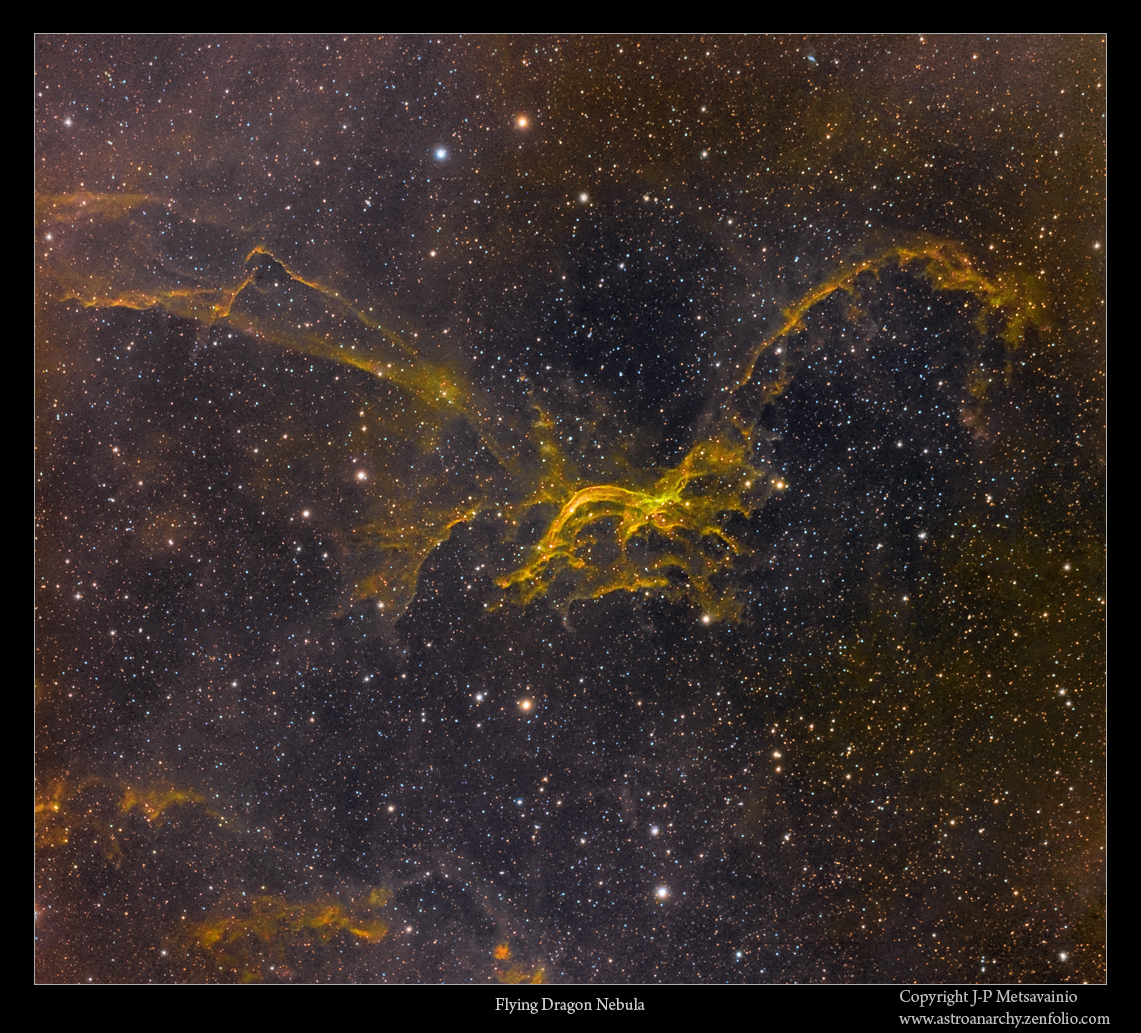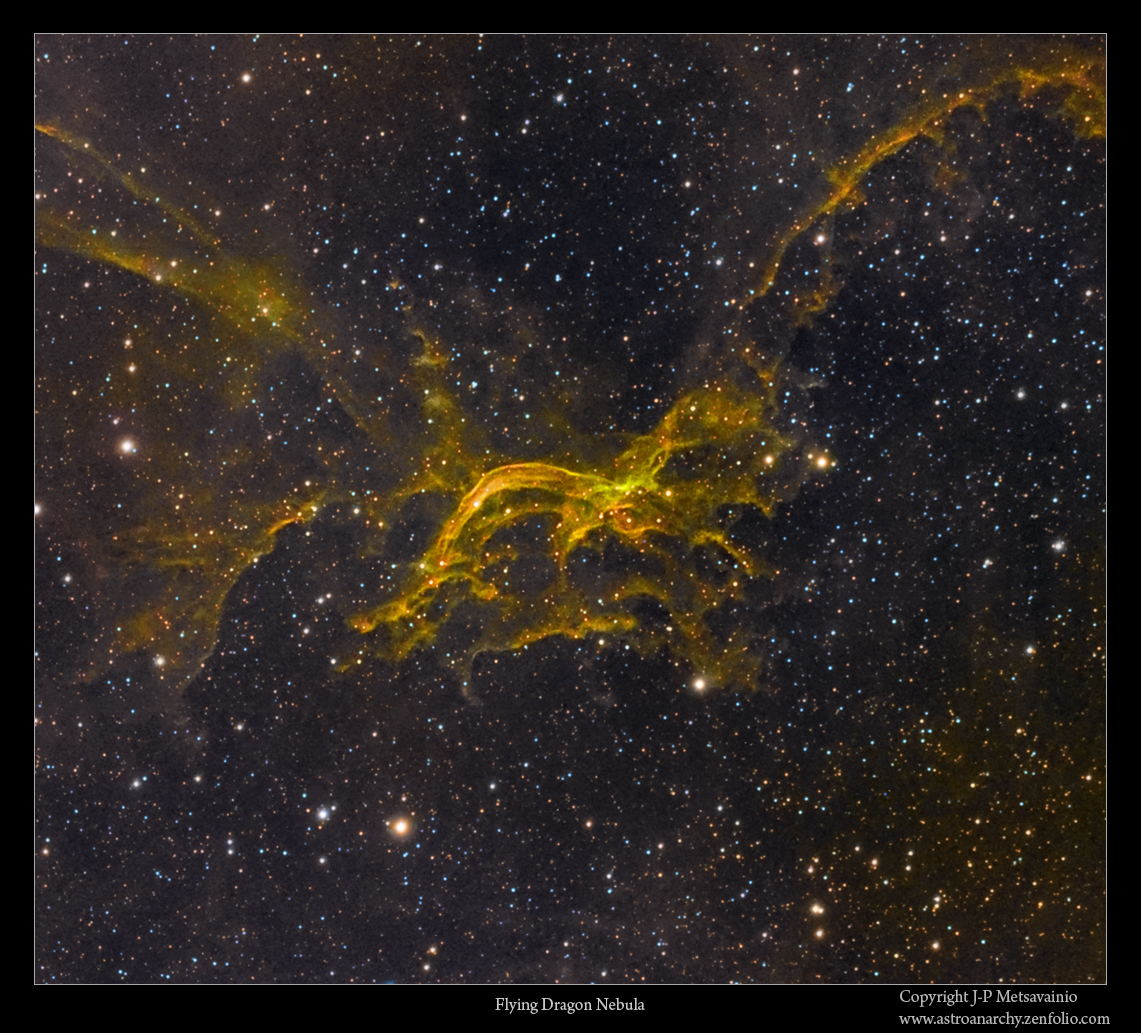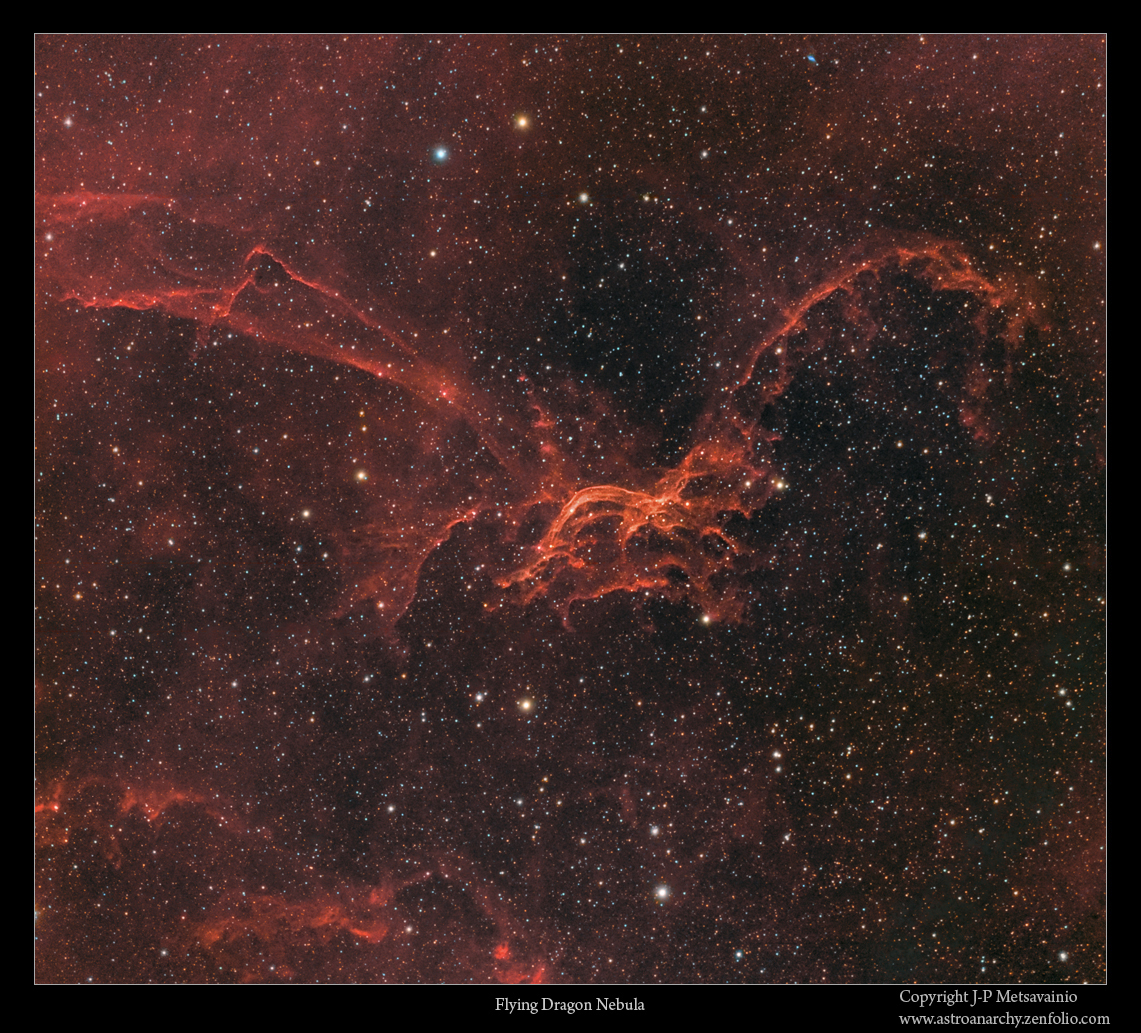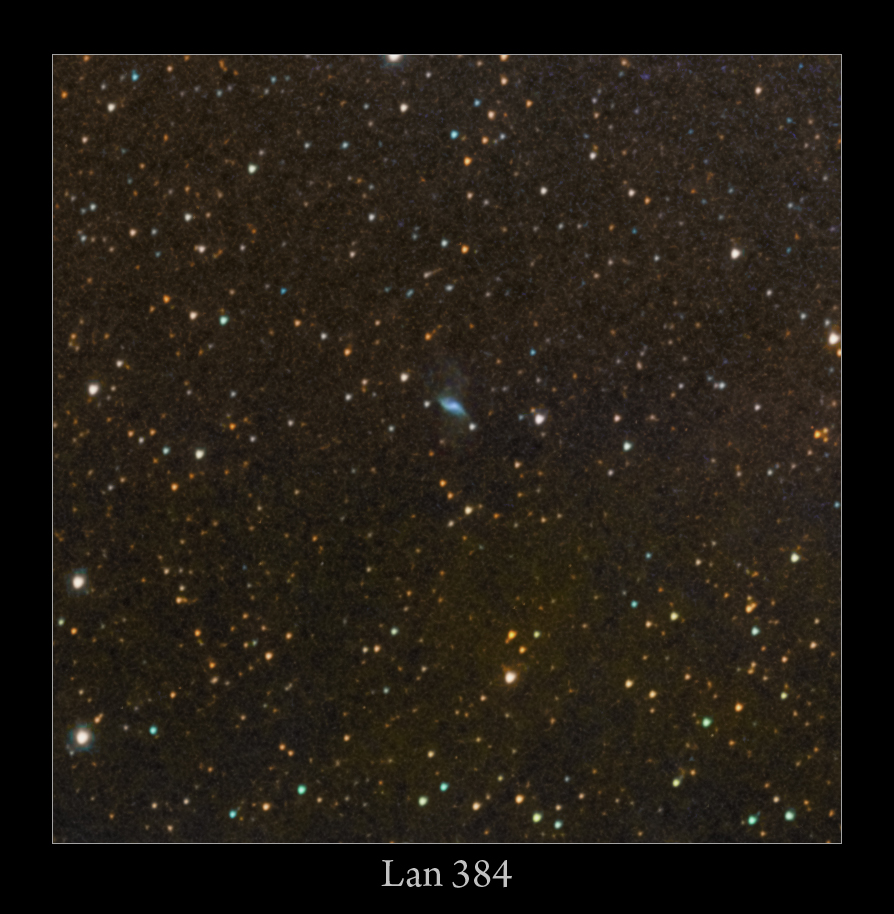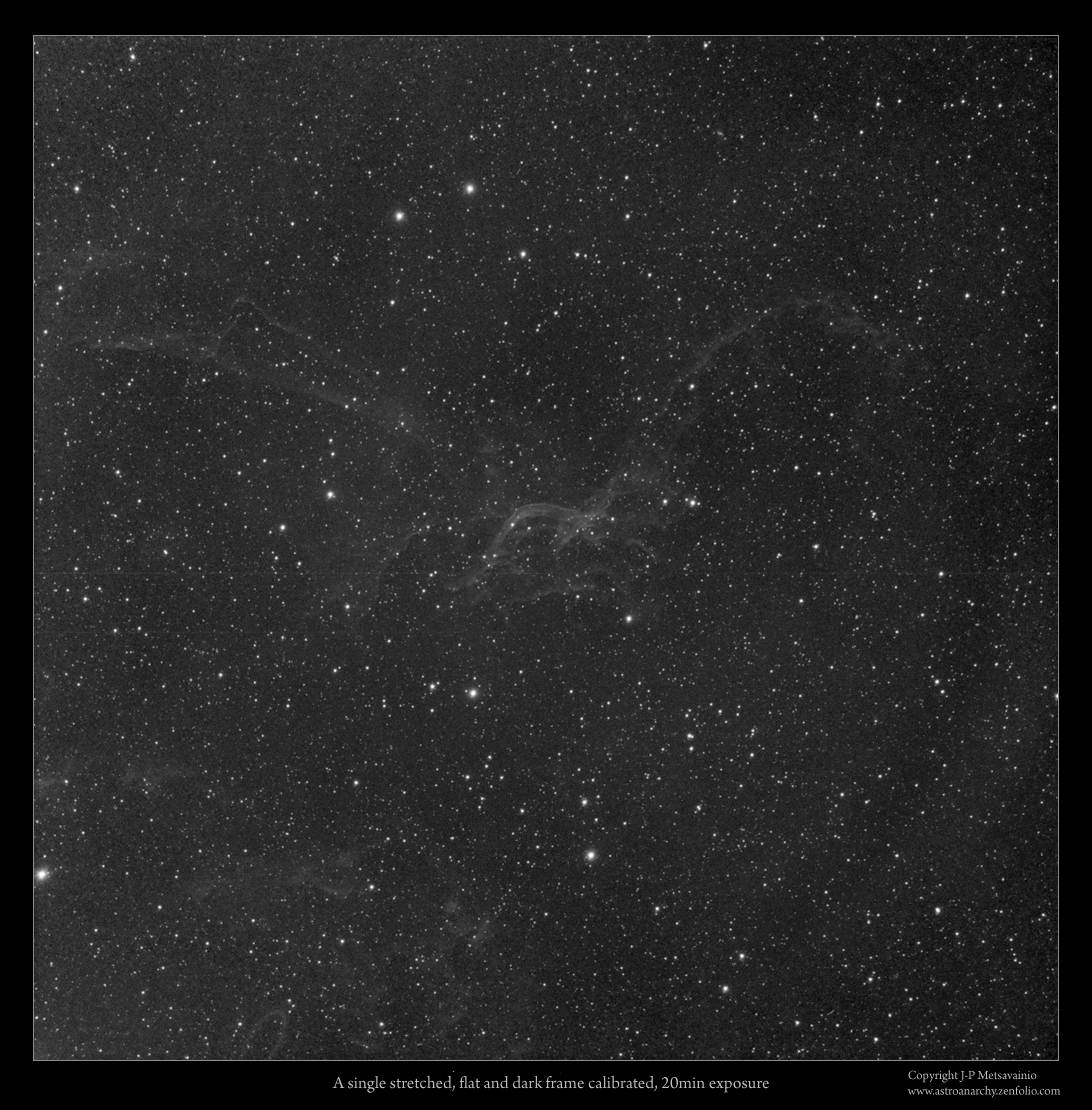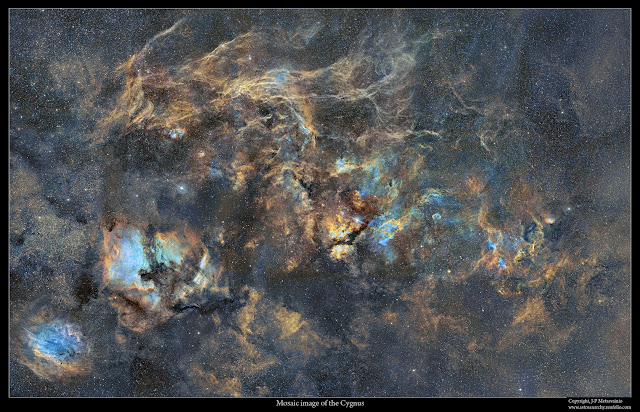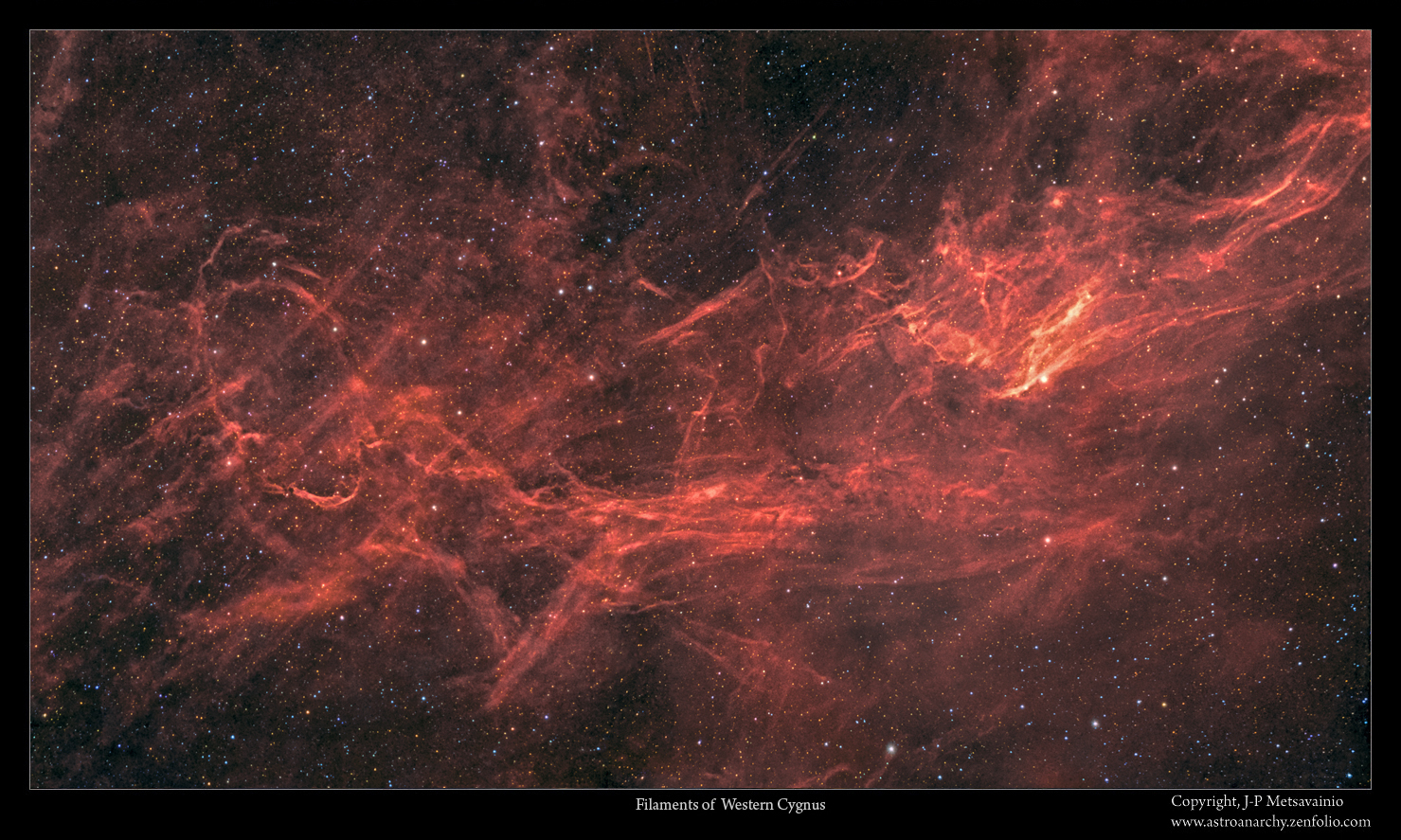COPYRIGHT, PLEASE NOTE
All the material on this website is copyrighted to J-P Metsavainio, if not otherwise stated. Any content on this website may not be reproduced without the author’s permission.
Have a visit in my portfolio
PORTFOLIO:https://astroanarchy.zenfolio.com/
Monday, November 9, 2015
Filaments of Cygnus
There are lots of dim gas filaments at west side of the Cygnus nebula complex. I have spent this Autumn season by shooting them. Due to close proximity of brighter and more eye catching nebulae in Cygnus, this area is not very commonly imaged.
Filaments of Cygnus
Click for a large imageNatural color composition from the emission of ionized elements.
Filaments of Cygnus in HST-mapped colors
Click for a large image
Image in mapped colors from the light emitted by ionized elements.
Red=Sulfur, Green=Hydrogen and Blue=Oxygen.
An experimental starless version
Click for a large imageAn experimental starless version
The actual nebula is easier to observe in this starless photo
A closeup
Interesting shapes in the nebula, they must be some kind of shock fronts
Orientation in the constellation Cygnus
Click for a large image
The area of interest is marked as a white rectangle in this 18-panels narrow band mosaic of the Cygnus.
Technical details
Processing work flow
Image acquisition, MaxiDL v5.07.
Stacked and calibrated in CCDStack2.
Deconvolution with a CCDStack2 Positive Constraint, 21 iterations, added at 25% weight
Color combine in PS CS3
Levels and curves in PS CS3.
Imaging optics
Celestron Edge HD 1100 @ f7 with 0,7 focal reducer for Edge HD 1100 telescope
Mount
10-micron 1000
Cameras and filters
Imaging camera Apogee Alta U16 and Apogee seven slot filter wheel
Guider camera, Lodestar x2 and SXV-AOL
Astrodon filter, 5nm H-alpha
Astrodon filter, 3nm O-III
Astrodon filter, 3nm S-II
Exposure times
H-alpha, 15 x 1200s = 5h.
O-III, 6 x 1200s binned = 2h
S-II, 6 x 1200s binned = 2h
Total 9h
Labels:
Narrowband color images,
nebula
Sunday, November 8, 2015
Sharpless 114, Sh2-114, the Flying Dragon Nebula
I have spent this Autumn season by shooting rarely imaged dimmer targets around Cygnus. So far I have stayed at Western parts of Cygnus nebula complex. This time I picked a target form the Eastern side, Sh2-114, the Flying Dragon Nebula. There are very few images out of this dim nebula.
This is a preliminary processing, I will shoot more exposures for this, whenever weather up here allows me to do so.
Sharpless-114, the Flying Dragon Nebula
Click for a large image
Click for a large image
The actual nebula is easier to observe in this starless version. At center left, there is an odd looking corkscrew like formation of glowing hydrogen and sulfur pointing upwards left. The pale bluish dot at top right is a bipolar planetary nebula Lan 384 or currently known as Kn 26.
Image in visual spectrum
Click for a large image
Natural color composition from the emission of ionized elements.
INFO
Sh2-114 is a complex and unusual HII emission nebula. Its complex, wispy structure is likely the result of winds from hot, massive stars interacting with the magnetic fields in the interstellar medium. But very little is known about it. (Source, https://www.noao.edu/image_gallery/html/im1112.html)
There is a planetary nebula at the same field of view, Lan 384 (Kn 26)
Using existing digital sky surveys, Jacoby et al. (2010) presented Kn 26, a bipolar PN candidate known for a long time as the emission line source Lan 384. Here we present high spatial-resolution optical and near-IR narrow-band images of this nebula, high-dispersion long-slit echelle spectra, and low-resolution spectroscopy. The new data confirm the PN nature of Kn 26 and reveal features typical of bipolar PNe: butterfly morphology, H2 emission, and nitrogen enrichment. A detailed analysis of the morphology and kinematics, however, suggests the possible presence of two pairs of bipolar lobes that would make Kn 26 a new member of the class of quadrupolar PN. (Source, http://www.iac.es/congreso/iaus283/pages/meeting/view-abstract.php?aid=138)
Lan 384 closeup
Info from Simbad database, http://simbad.u-strasbg.fr/simbad/sim-id?Ident=Lan+384
Some latest info confirms this a s bipolar planetary nebula, http://www.iac.es/congreso/iaus283/pages/meeting/view-abstract.php?aid=138
Technical details
Processing work flow
Image acquisition, MaxiDL v5.07.
Stacked and calibrated in CCDStack2.
Deconvolution with a CCDStack2 Positive Constraint, 21 iterations, added at 25% weight
Color combine in PS CS3
Levels and curves in PS CS3.
Imaging optics
Celestron Edge HD 1100 @ f7 with 0,7 focal reducer for Edge HD 1100 telescope
Mount
10-micron 1000
Cameras and filters
Imaging camera Apogee Alta U16 and Apogee seven slot filter wheel
Guider camera, Lodestar x2 and SXV-AOL
Astrodon filter, 5nm H-alpha
Astrodon filter, 3nm O-III
Astrodon filter, 3nm S-II
Exposure times
H-alpha, 9x 1200s = 3h
O-III, 3 x 1200s binned = 1h
S-II, 3 x 1200s binned = 1h
Total 5h
A single uncropped, calibrated and stretched 20 min. H-alpha frame as it comes from the camera
Labels:
Narrowband color images,
nebula
Saturday, October 31, 2015
Filaments of the Western Cygnus
I have spent some clear nights by shooting dim gas structures in Western part of the nebula rich constellation Cygnus. This area of Cygnus is not commonly imaged due to low surface brightness and close proximity of more eye catching nebulae. My previous project of Western Cygnus can be seen in this blog post.
This time I shot a formation around the magnitude 3,96 star, OMI02 Cygni. It can be seen as a most brightest star at middle right. This is a two frame mosaic image.
Filaments of Cygnus
Please, click for a large image
Filaments of glowing gas around the star OMI02 Cygni. Image is in mapped colors from the light emitted by the ionized elements. Red=Sulfur, Green=Hydrogen and Blue=Oxygen.
Filaments of glowing gas around the star OMI02 Cygni. Image is in mapped colors from the light emitted by the ionized elements. Red=Sulfur, Green=Hydrogen and Blue=Oxygen.
An experimental starless version
Please, click for a large image
In this starless version the gas filaments can be seen better. (I let a one star for a compositional reasons.)
Image in visual spectrum
Please, click for a large image
Natural color composition from the emission of ionized elements.
Natural color composition from the emission of ionized elements.
This palette is very close to a visual spectrum.
Images in this post are a small part of the Cygnus nebula complex
Please, click for a large image, 2200 x 1400 4,2MB
Technical details
Processing work flow
Image acquisition, MaxiDL v5.07.
Stacked and calibrated in CCDStack2.
Deconvolution with a CCDStack2 Positive Constraint, 21 iterations, added at 25% weight
Color combine in PS CS3
Levels and curves in PS CS3.
Imaging optics
Celestron Edge HD 1100 @ f7 with 0,7 focal reducer for Edge HD 1100 telescope
Canon EF 200mm f1.8 lens
Mount
10-micron 1000
Cameras and filters
Imaging camera Apogee Alta U16 and Apogee seven slot filter wheel
Guider camera, Lodestar x2 and SXV-AOL
QHY9 for S-II and O-III emsissions
Astrodon filter, 5nm H-alpha
Baader O-III
Baader S-II
Exposure times
H-alpha, 24 x 1200s = 8h
O-III, 8 x 600s = 1h 20min.
S-II, 8 x 600s = 1h 20min.
Total 10h
Labels:
Narrowband color images,
nebula
Thursday, October 29, 2015
Filaments of Cygnus, project continues
At night of 27. October I managed to shot some new lights for this interesting area in the Western Cygnus. Speeding clouds ruined most of my imaging session but I got just enough exposures to make this two frame mosaic. At some point, I'll shoot more data for O-III and S-II, at the moment the signal is extremely low. I got it processed by using the powerful Tone Mapping v2 workflow.
Filaments of Cygnus, a two frame mosaic
Red=Sulfur, Green=Hydrogen and Blue=Oxygen.
A starless view
Image in visual spectrum
Please, click for a large image
This palette is very close to a visual spectrum.A starless view
Please, click for a large image
Complex structures of the ionized gas stands out nicely in this experimental starless view.
Complex structures of the ionized gas stands out nicely in this experimental starless view.
Closeups
Please, click for a large image
Ring Of Fire
Please, click for a large image
Image description
Love is a burnin' thing,
And it makes a fiery ring
Bound by wild desire
I fell into a ring of fire.
I fell into a burnin' ring of fire
I went down, down, down
And the flames went higher,
And it burns, burns, burns,
The ring of fire, the ring of fire.
(Johnny Cash - Ring Of Fire, Lyrics by June Carter )
INFO
I noticed this ring back at November 2011. At the time I was shooting a less known area at the Western Cygnus. This looped gas formation got my attention. The "Cirrus of Cygnus" was a small part of the large mosaic image of the Cygnus nebula complex.
Few days ago, I got an email from Sakib Rasool. He told me, that a French astrophotographer Pascal Le Dû has reported this as a new planetary nebula or supernova remnant candidate, Du 2. More info here: http://www.cielocean.fr/index.php?page=ldu2
Here is an animation from November 2011, I made it to get a better view to this formation.

Few days ago, I got an email from Sakib Rasool. He told me, that a French astrophotographer Pascal Le Dû has reported this as a new planetary nebula or supernova remnant candidate, Du 2. More info here: http://www.cielocean.fr/index.php?page=ldu2
Here is an animation from November 2011, I made it to get a better view to this formation.

Image was taken at November 2011. I removed the stars to see the actual nebula better.
Canon EF 200mm f1.8 optics, QHY9 astro camera and Baader narrowband filters.
Images in this post are a small part of the Cygnus nebula complex
Please, click for a large image, 2200 x 1400 4,2MB
A 18-panels narrow band mosaic of the constellation Cygnus overlaid with Cartes Du Ciel screenshot.. Area of interest can be seen at about eleven o'clock position in this image as a blue regtangle.
Technical details
Processing work flow
Image acquisition, MaxiDL v5.07.
Stacked and calibrated in CCDStack2.
Deconvolution with a CCDStack2 Positive Constraint, 21 iterations, added at 25% weight
Color combine in PS CS3
Levels and curves in PS CS3.
Imaging optics
Celestron Edge HD 1100 @ f7 with 0,7 focal reducer for Edge HD 1100 telescope
Mount
10-micron 1000
Cameras and filters
Imaging camera Apogee Alta U16 and Apogee seven slot filter wheel
Guider camera, Lodestar x2 and SXV-AOL
Astrodon filter, 5nm H-alpha
Astrodon filter, 3nm O-III
Astrodon filter, 3nm S-II
Exposure times
H-alpha, 24 x 1200s = 8h
O-III, 4 x 1200s binned = 1h 20min.
S-II, 4 x 1200s binned = 1h 20min.
Total 10h
Labels:
Narrowband color images,
nebula
Subscribe to:
Posts (Atom)





